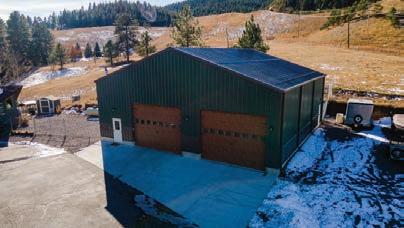











Meet Soli!
The shelter at its
is
was adopted days before, but things are strained between him and the resident dog. Since we have nowhere to take him back, we are assisting in finding him a better situation. He LOVES people, kids and has done well with other dogs. This busy family doesn’t have the time to work with him and feel he may do better in a quieter home. Please email info@imhs.org today!


















































As Cities Deal With Homelessness & Affordability, Look for a Greater Focus on Manufactured Homes
Two weeks ago, this column was about Colorado’s new law requiring jurisdictions to facilitate the construction of accessory dwelling units (ADUs) on parcels zoned single-family.

houses in a factory seemed impractical. However, with our patented shipping technology, merging housing with assembly line mass production could be a game changer.”
portant factor is solving our housing shortage.

Toward the end of that column I promoted two companies, Verdant Living and Boxabl, which sell ADUs which are factorybuilt and assembled onsite.
This week’s topic was inspired by the following statement contained in an email last week from Boxabl: “Did you know that car factories, like Ford, can output one car per minute? Why hasn’t anyone done that in the housing industry?
“It’s shocking to hear that homelessness in the U.S. reached an all-time high last year. At Boxabl, we’re committed to making a difference. We’re working hard to solve the problems that have stopped factory-built housing from gaining market share.
“Before Boxabl, the concept of building
In earlier columns I have written about modular and manufactured homes by other companies, including my Oct. 12, 2023, column featuring Dvele (Norwegian for “dwell”) whose website (www.Dvele.com) boasts that it has already delivered nearly 300 “modules” of “precision engineered sustainable homes.”
Dvele defines the problem thus: “We’re facing multiple crises in housing, availability and affordability, energy, security, health issues, and a changing weather system. With Dvele, we sit at the intersection with our mass produced, high performance, health centric homes. And they’re improving the future for everyone.”
Dvele claims that by manufacturing homes in a factory and assembling them onsite, they reduce construction time by 80% — an im-
On May 18, 2023, I wrote about another company, Liv-Connected, which specializes in small homes that are “ready to ship and install within 12 weeks. These are small homes, although they offer versions up to 2,500 square feet, including a 2-story model. Homes can be delivered on standard flat-bed trailers and can be installed onsite in as little as a day, once site preparation (foundation, etc.) is complete. Like Boxabl, they also sell a model that is on wheels built to RV standards. Their website is www.Liv-Connected.com

With prices as low as $165,000 for a 500square-foot home, Liv-Connected’s singlefamily Conexus model (pictured at left) has been selected by Hawaii and Texas for disaster response initiatives, according to the website.
I look forward to hearing more about manufactured housing in the future, especially as it relates to homelessness.
U.S. Farmers Are Turning Less Soil
Modern, mechanized tillage had become an ecological disaster, killing all that was alive in the soil while worsening erosion and runoff. But this is all changing, primarily because farmers recognize the economic benefits — less fertilizer and diesel fuel to buy, lower labor costs, higher crop yields and profits — that can come with no-till farming or reduced tillage…
The shift has been gradual, but sweeping over time. In 1973, 82.2 percent of U.S. cropland was managed by conventional tillage, according to the Agriculture Department, and only 2 percent was managed by “no-till” methods, with the remaining 15.8 percent using reduced tillage. Half a century later, only 27 percent of U.S. cropland uses conventional tillage, with 38 percent now using no-till and 35 percent using reduced tillage, according to the USDA’s 2022 agricultural census, released last year. The acreage under conventional tillage dropped by 8 percent between 2017 and 2022 alone.
—Dana
Millbank, Washington Post
Buyers Need and Deserve Professional Representation, But Here’s Why They Shouldn’t Have to Pay for It
It should be clear by now that “not much has changed” regarding sellers compensating the buyer’s broker in most real estate transactions. What has changed is that buyer agents must use other means than the MLS (e.g., calling the listing agent) to find out what compensation is offered for each listing.
First, let me outline the important services that are required in any transaction. Let’s start with all transactions, whether or not the buyer is taking out a mortgage loan.
Although the purchase contract can move some of these expenses to the seller’s side, that is rare, because it will make the purchase offer less attractive, with the buyer losing out:
For All Home Purchases:
Recording the deed with the county
Tax certificate
State document fee
Half of the closing services fee
Appraisal (if ordered)
HOA fees (if applicable, per contract)
Water & sewer adjustments
Additional Costs with a Mortgage:
Mortgage title policy & endorsements
Mortgage closing fee
Recording the deed of trust with county
Tax service (if charged by lender)
First year’s insurance premium
2 to 3 months’ insurance reserve (escrow)
1 to 2 months’ property tax reserve
Loan origination and discount fee
Survey (if required by lender)
Credit report
Interest on loan (based on closing date)
Mortgage insurance (if over 80% LTV)
Flood certificate & insurance if required
How much do these closing costs add up to for the buyer? In the cash scenario, they are not that much, and just over 20% of closings
are for cash nowadays. For closings that involve mortgage financing, however, those costs can really add up. My buyer who closed on a $630,000 purchase two months ago paid $7,144 in closing costs, which computes to 11.3%. If she had to pay my commission that would have been 14.1% The seller’s closing costs on the same transaction came to $2,834, which computes to 4.5% of the purchase price. Paying my commission raised the seller’s cost to 7.3%, still far lower than the 11.3% paid by the buyer without paying me anything for my services representing her.
From a purely cash standpoint, it should be remembered that the seller is the only one walking away with cash from the transaction. In the above case, not counting the deduction for property taxes and mortgage payoff, the seller netted $591,444.74, or about 94% of the purchase price, even after paying both agents’ compensation.
Buyers’ agents perform a variety of important services, which someone has to pay for, but the seller is the only party coming away with money, and the buyer is already stretched by those other expenses detailed at left.
The services provided by a buyer’s agent are important and significant, but the plaintiffs in the class action suit a year ago asserted that compensating the buyer’s agent should be added to the buyer’s other significant closing costs. The 2024 survey of buyers and sellers by the National Association of Realtors (NAR) asked what services buyers most appreciated from their agents:
Helped them understand the process (61%)
Pointed out unnoticed features/faults with the property (58%)
Negotiated better contract terms (46%)
Provided a list of good service providers, such as inspectors (46%)

Improved buyers’ knowledge of search areas (45%)
Negotiated a better purchase price (33%)
Shortened their home search (23%)
Expanded their search area (21%)
I contend that it is appropriate that sellers compensate the buyer’s agent, and that this is common in other industries besides real estate. Look at Amazon. When you purchase a product through that website, Amazon is your agent for the vendor, which pays Amazon 8% to 45% as a “referral fee.” When you purchase something through an app on your
iPhone, you pay the same price as on the vendor’s website, but Apple keeps 30% of the purchase price as a commission. If Amazon or an app were to charge you a fee on top of the list price… well, it simply wouldn’t work. If you hire an auto broker (as I did in 2012 for a hard-to-find car), the dealership, not you, pays the auto broker a commission. Likewise, virtually every new home builder offers a 3 percent commission, typically, to the agents who represent buyers. To offer less puts them at a competitive disadvantage. Why should it be different in the resale market?











































